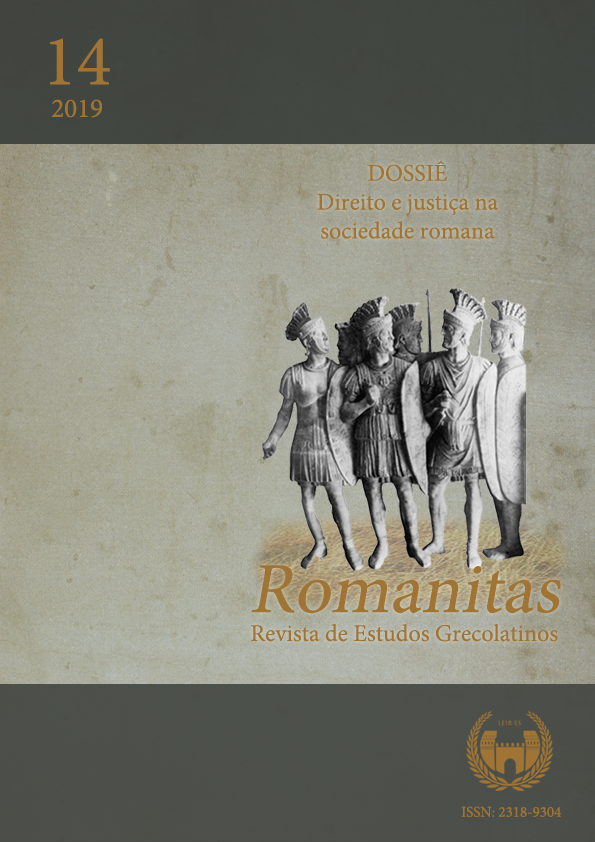From social death to social rebirth: law, slavery and freedom in Classical Rome
DOI:
https://doi.org/10.17648/rom.v0i14.28890Keywords:
Rome, Roman law, Slavery, ManumissionAbstract
In this paper, the problems about slavery and liberty in Roman law are discussed. The problems in the recognition of a slave’s humanity while stablishing a juridical notion of thing – res. It was determined as time frames the importance of the topic about slavery in the Italian Peninsula until their decline. The research happened in various romans juridical fronts: the Institutes of Gaius, the Rules of Ulpiano and the Justiano’s Digest. Various historiographical bases were taken notice as academical references. The methodology consisted in the confrontation between juridical opinions registered in the chosen fonts and interpretations collected in bibliographical platforms.
Downloads
References
Documentação textual
ARISTÓTELES. A política. Rio de Janeiro: Nova Fronteira, 2011.
MARCUS TULLIUS CICERO. Stoic Paradoxes (Paradoxa Stoicorum). In: ______. Cicero’s three books of offices, or moral duties. New York: Harper & Brothers, 1892.
MARCUS TULLIUS CICERO. The tenth oration of M. T. Cicero against Marcus Antonius called also the tenth Philippic. In: ______. The orations of Marcus Tullius Cicero. A Public Domain Book, 1903. 4 v.
GAIUS. Institutiones or Institutes of Roman Law by Gaius. Oxford: Clarendon Press, 1904.
GAIUS. Institutionum iuris civilis comentarii quattuor. Traduction by James Muirhead. In: ______. The institutes of Gaius and rules of Ulpian: the former from studemund’s aprografh of the Verona Codex. Edinburgh: T. & T. Clarck, Law Booksellers, 1880.
ULPIANO. Fragmenta: sive excerta, Ulpiani libro singulari regularum. Traduction by James Muirhead. In: ______. The Institutes of Gaius and rules of Ulpiano: the former from Studemund’s Apograph of the Verona Codex. Edinburgh: T. & T. Clark, Law Bookselllers, 1880.
THE DIGEST OF JUSTINIAN. Traduction by Alan Watson. Philadelphia: University of Pennsylvania, 1998. 4 v.
Obras de apoio
ALLAIN, J. The legal understanding of slavery: from the historical to the contemporary. Oxford: Oxford University, 2018.
ALVES, J. C. M. Direito Romano. São Paulo: Forense, 2010.
BLACKBURN, R. The American crucible: slavery, emancipation and human rights. London: Verso, 2013.
BRADLEY, K. Slavery and society at Rome. Cambridge: Cambridge University, 1994.
BRETONE, M. História do Direito Romano. Lisboa: Estampa, 1998.
BUCKLAND, W. W. The Roman law of slavery: the condition of the slave in private law from Augustus to Justinia. New Jersey: The Lawbook Exchange, 2007.
BURDICK, W. L. The principles of Roman Law and their relation to Modern Law. New Jersey: The Lawbook Exchange Ltd., 2007.
DUCOS, M. Roma e o Direito. São Paulo: Madras, 2007.
DUMONT, J. C. Servus: Rome et l’esclavage sous la République. Paris: École Française de Rome, 1987.
FINLEY, M. I. Escravidão antiga e ideologia moderna. Rio de Janeiro: Graal, 1991.
GARDNER, J. F. Being a Roman citizen. Londres: Routledge, 1993.
HINDESS, B.; HIRST, P. Modos de produção pré-capitalistas. Rio de Janeiro: Zahar, 1976.
HADDAD, A. B. Vlastos e a escravidão em Platão. Revista Clássica, v. 28, n. 2. p. 93‑103, 2015.
JOLY, F. D. A escravidão na Roma Antiga. São Paulo: Alameda, 2013.
LOPES, J. R. O Direito na história: lições introdutórias. São Paulo: Max Limonad, 2002.
MARKY, T. Curso elementar de Direito Romano. São Paulo: Milesi, 1981.
MEILLASSOUX, C. Antropologia da escravidão: o ventre de ferro e dinheiro. Rio de Janeiro: Zahar, 1995.
MENDES, F. L. R. Escravidão e ordem política: uma comparação entre a ‘Política’ de Aristóteles e ‘A Utopia’ de Thomas More. Primeiros Estudos, n. 6, p. 65-75, 2014.
NICOSIA, E. Manumissio per epistulam. Revue Internationale des Droits de l’Antiquité, v. 47, p. 221-233, 2000.
PATTERSON, O. Slavery and social death: a comparative study. Cambrigde: Harvard University Press, 1982.
PELLOSO, C. Serviles personae in Roman Law. Journal of Global Slavery, v. 3, p. 92‑128, 2018.
SIRKS, A. J. B. The Lex Junia and the effects of informal manumission and iteration. Revue Internationale des Droits de l’Antiquité, v. 30, p. 211-292, 1983.
SMITH, W. Dictionary of Greek and Roman antiquities. London: John Murray, 1875.
VETTER, B. K. The historical development of some important methods of manumission in Roman Law. Revue internationale des Droits de l’Antiquité, v. 51, p. 355-368, 2004.
WATSON, A. Seventeenth-Century jurists, Roman Law, and the Law of Slavery. The Chicago‑Kent Review, v. 68, n. 3, p. 1343-1354, 1992.
WATSON, A. Slave Law in the Americas. Athens: University of Georgia, 1989.
WATSON, A. Thinking property at Rome. The Chicago‑Kent Review, v. 68, n. 3, p. 1355‑1371, 1993.
WOOD, E. M. Landlords and peasants, masters and slaves: class relations in Greek and Roman Antiquity. Historical Materialism, v. 10, n. 3, p. 17-69, 2000.
Downloads
Published
How to Cite
Issue
Section
License

This work is licensed under a Creative Commons Attribution-NonCommercial-NoDerivatives 4.0 International License.
a. The authors retain copyright and grant the journal the right to first publication.
b. The authors are authorized to assume additional contracts separately, for non-exclusive distribution of the version of the work published in this journal (e.g., publishing in institutional repository or as a book chapter), with acknowledgment of authorship and initial publication in this journal.
c. Authors are allowed and encouraged to publish and distribute their work online (e.g. in institutional repositories or on their personal page) after the first publication by the journal, with due credit.
d. The journal's texts are licensed under a CC BY 4.0 Deed Attribution 4.0 International Licence (CC BY).




























